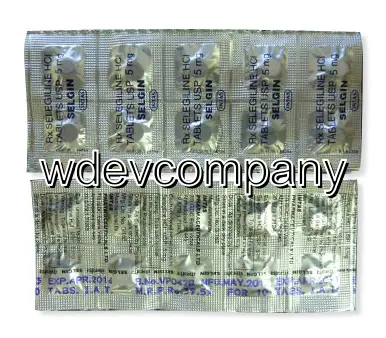| Package | Dosage | Price | Price per Dose | |
|---|---|---|---|---|
| Dosage: 5mg | ||||
| 360 pill | 5mg | $411.12 | $1.14 | |
| 240 pill | 5mg | $286.37 | $1.19 | |
| 180 pill | 5mg | $224.88 | $1.25 | |
| 120 pill | 5mg | $168.65 | $1.41 | |
| 90 pill | 5mg | $137.03 | $1.53 | |
| 60 pill | 5mg | $103.65 | $1.72 | |
| 30 pill | 5mg | $63.23 | $2.11 | |
| Dosage: 10mg | ||||
| 240 pill | 10mg | $391.79 | $1.63 | |
| 120 pill | 10mg | $198.52 | $1.65 | |
| 90 pill | 10mg | $156.36 | $1.74 | |
| 60 pill | 10mg | $108.92 | $1.83 | |
| 30 pill | 10mg | $57.96 | $1.95 | |

Selegiline Description
Overview of Selegiline
Selegiline, also known by its chemical name, L-deprenyl, is a medication primarily used in the treatment of Parkinson's disease and major depressive disorder. It belongs to a class of drugs called monoamine oxidase inhibitors (MAOIs). By inhibiting the activity of the enzyme monoamine oxidase B (MAO-B), Selegiline helps increase the levels of certain neurotransmitters in the brain, such as dopamine, which play essential roles in mood regulation and motor control. The medication is available in various forms, including tablets and patches, allowing for flexible administration depending upon the patient's needs.
How Selegiline Works
Selegiline's primary mechanism involves selectively blocking MAO-B, which is responsible for breaking down dopamine in the brain. By inhibiting this enzyme, Selegiline increases dopamine availability, which can improve symptoms related to dopamine deficiency, such as those seen in Parkinson's disease. When used at higher doses, Selegiline may also influence MAO-A, potentially affecting other neurotransmitters like serotonin and norepinephrine, which can contribute to its antidepressant effects. Its selectivity for MAO-B at lower doses helps reduce some of the dietary restrictions traditionally associated with older MAOIs, making it a more tolerable option for many patients.
Medical Uses and Benefits
One of the most common uses of Selegiline is in managing Parkinson's disease. It is often prescribed as an adjunct therapy alongside levodopa or other antiparkinsonian medications. Patients tend to experience improved motor function and a reduction in the "wearing-off" phenomena, where medication effects diminish before the next dose is due. In cases of depression, especially treatment-resistant major depressive disorder, Selegiline may be effective due to its influence on brain neurotransmitter balance. The transdermal patch formulation offers a convenient option for some individuals, providing steady medication delivery and reducing gastrointestinal side effects.
Potential Side Effects and Safety
While Selegiline is generally well-tolerated, it can cause side effects in some users. Common adverse reactions include headache, dizziness, nausea, dry mouth, and insomnia. Since it affects neurotransmitter levels, there is a risk of hypertensive crisis if foods rich in tyramine are consumed, especially at higher doses where MAO-A is affected. Patients are advised to adhere to dietary restrictions and consult their healthcare provider for guidance. Serious, but rare, side effects include hallucinations, agitation, or liver function abnormalities. As with any medication, monitoring by a healthcare professional is essential to ensure safety and efficacy.
Summary
Selegiline stands out as a versatile medication with proven benefits for both Parkinson's disease and depression. Its ability to increase dopamine levels helps alleviate motor symptoms and elevate mood. The availability of different forms, including patches, enhances patient compliance and reduces some dietary concerns associated with traditional MAOIs. However, careful attention to dosage and dietary restrictions is vital to minimize potential risks. Overall, Selegiline presents an effective treatment option for individuals seeking relief from complex neurological and mental health conditions, provided that its use is appropriately managed by medical professionals.
